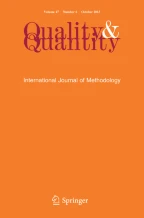Abstract
The arising air pollution has addressed much attention globally due to its detrimental effects on human health and environment. As an early warning system for air quality control and management, it is important to provide precise information about the future concentrations in pollutants. We present here a time series model in predicting the Air Pollution Index (API) from three different stations; industrial, residential, and sub-urban areas between 2000 and 2009. In this paper, the Box–Jenkins approach of seasonal autoregressive integrated moving average (ARIMA), artificial neural network (ANN), and three models of fuzzy time series (FTS) have been compared by using the mean absolute percentage error, mean absolute error, mean square error, and root mean square error. Although all the methods were used as operational tools, the ANN seemed more accurate in forecasting API. The results showed that FTS (i.e. Chen’s, Yu’s, and Cheng’s) performed inconsistent results since the conventional methods of ARIMA outperformed the performance of FTS. However, consistent results were achieved as the ANNs gave the smallest forecasting error compared to FTS and ARIMA.
Similar content being viewed by others
Explore related subjects
Discover the latest articles, news and stories from top researchers in related subjects.References
Afroz, R., Hassan, M.N., Ibrahim, N.A.: Review of air pollution and health impacts in Malaysia. Environ. Res. 92(2), 71–77 (2003)
Armstrong, J.S., Collopy, F.: Error measures for generalizing about forecasting methods: empirical comparisons. Int. J. Forecast. 8(1), 69–80 (1992). doi:10.1016/0169-2070(92)90008-w
Bernard, E.A.: F.: Fuzzy approaches to environmental decisions: application to air quality. Environ. Sci. Policy 9(1), 22–31 (2006). doi:10.1016/j.envsci.2005.08.006
Bernard, F.: Fuzzy environmental decision-making: applications to air pollution. Atmos. Environ. 37(14), 1865–1877 (2003). doi:10.1016/s1352-2310(03)00028-1
Caselli, M., Trizio, L., Gennaro, Gd, Ielpo, P.: A simple feedforward neural network for the PM10 forecasting: comparison with a radial basis function network and a multivariate linear regression model. Water Air Soil Pollut. 201, 365–377 (2009). doi:10.1007/s11270-008-9950-2
Chen, S.M.: Forecasting enrollments based on high-order fuzzy time series. Cybern. Syst. 33(1), 1–16 (2002)
Cheng, C.-H., Chen, T.-L., Teoh, H.J., Chiang, C.-H.: Fuzzy time-series based on adaptive expectation model for TAIEX forecasting. Expert Syst. Appl. 34(2), 1126–1132 (2008)
Cryer, J.D.: Time Series Analysis, 1st edn. Duxbury Press, Belmont (1986)
Faraway, J., Chatfield, C.: Time series forecasting with neural networks: a comparative study using the air line data. J. R. Stat. Soc.: Series C 47(2), 231–250 (1998). doi:10.1111/1467-9876.00109
Hanke, J.E., Wichern, D.W.: Business Forecasting, 8th edn. Pearson/Prentice Hall, Upper Saddle River (2005)
Hassanzadeh, S., Hosseinibalam, F., Alizadeh, R.: Statistical models and time series forecasting of sulfur dioxide: a case study Tehran. Environ. Monit. Assess. 155(1), 149–155 (2009). doi:10.1007/s10661-008-0424-1
Heo, J.-S., Kim, D.-S.: A new method of ozone forecasting using fuzzy expert and neural network systems. Sci. Total Environ. 325(1–3), 221–237 (2004). doi:10.1016/j.scitotenv.2003.11.009
Hui-Kuang, Y.: Weighted fuzzy time series models for TAIEX forecasting. Phys. A: Stat. Mech. Appl. 349(3–4), 609–624 (2005)
Ibrahim, M.Z., Zailan, R., Ismail, M., Lola, M.S.: Forecasting and time series analysis of air pollutants in several area of Malaysia. Am. J. Environ. Sci. 5(5), 625–632 (2009). doi:10.3844/ajessp.2009.625.632
Kampa, M., Castanas, E.: Human health effects of air pollution. Environ. Pollut. 151(2), 362–367 (2008)
Kumar, A., Goyal, P.: Forecasting of daily air quality index in Delhi. Sci. Total Environ. 409(24), 5517–5523 (2011). doi:10.1016/j.scitotenv.2011.08.069
Kurt, A., Oktay, A.B.: Forecasting air pollutant indicator levels with geographic models 3 days in advance using neural networks. Expert Syst. Appl. 37(12), 7986–7992 (2010)
Morabito, F.C., Versaci, M.: Fuzzy neural identification and forecasting techniques to process experimental urban air pollution data. Neural Netw. 16(3–4), 493–506 (2003). doi:10.1016/s0893-6080(03)00019-4
Perez, P., Salini, G.: PM2.5 Forecasting in a large city: comparison of three methods. Atmos. Environ. 42(35), 8219–8224 (2008)
Rizzo, A., Glasson, J.: Iskandar Malaysia. Cities(0) (2011). doi:10.1016/j.cities.2011.03.003
Sansuddin, N., Ramli, N., Yahaya, A., Yusof, N., Ghazali, N., Madhoun, W.: Statistical analysis of PM10 concentrations at different locations in Malaysia. Environ. Monit. Assess. 180(1), 573–588 (2011). doi:10.1007/s10661-010-1806-8
Shyi-Ming, C.: Forecasting enrollments based on fuzzy time series. Fuzzy Sets Syst. 81(3), 311–319 (1996)
Song, Q., Chissom, B.S.: Forecasting enrollments with fuzzy time series – Part I. Fuzzy Sets Syst. 54(1), 1–9 (1993a)
Song, Q., Chissom, B.S.: Fuzzy time series and its models. Fuzzy Sets Syst. 54(3), 269–277 (1993b)
Wang, X.K., Lu, W.Z.: Seasonal variation of air pollution index: Hong Kong case study. Chemosphere 63(8), 1261–1272 (2006)
World Resources Institute: (2002) Rising Energy Use: Health Effects of Air Pollution. World Resources Institute. http://www.airimpacts.org (2002). Accessed January 10, 2011
Zhang, G., Eddy Patuwo, B., Hu, M.Y.: Forecasting with artificial neural networks: the state of the art. Int. J. Forecast. 14(1), 35–62 (1998). doi:10.1016/s0169-2070(97)00044-7
Author information
Authors and Affiliations
Corresponding author
Rights and permissions
About this article
Cite this article
Rahman, N.H.A., Lee, M.H., Suhartono et al. Artificial neural networks and fuzzy time series forecasting: an application to air quality. Qual Quant 49, 2633–2647 (2015). https://doi.org/10.1007/s11135-014-0132-6
Published:
Issue Date:
DOI: https://doi.org/10.1007/s11135-014-0132-6
